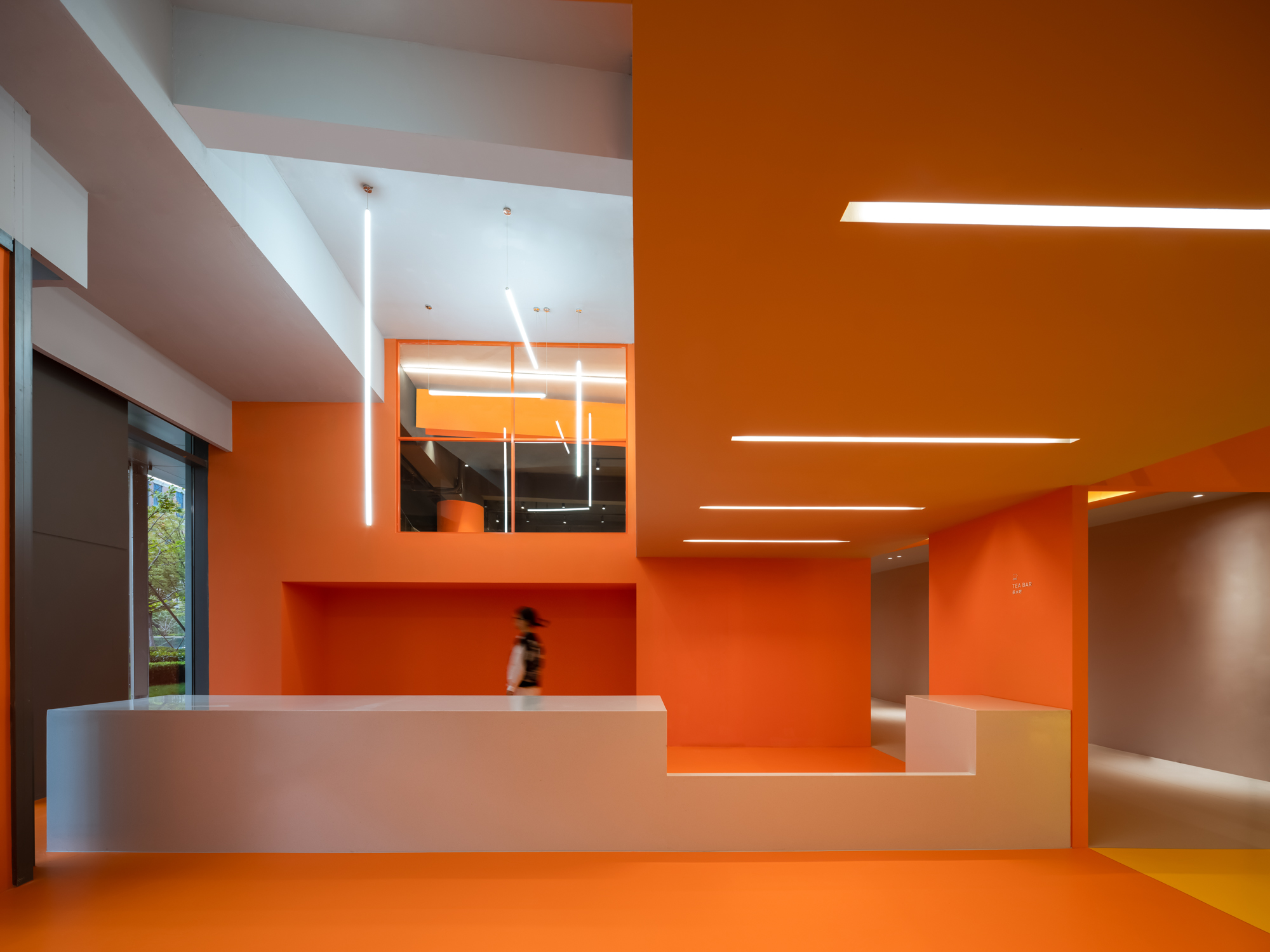

设计单位 杭州植田建筑室内设计工作室、不建建筑(杭州)有限公司
项目地点 浙江杭州
完工时间 2022年 7月
建筑面积 600平方米
撰文 王明皓、方润武
莫比斯加速器办公室(MOBIUS)是受国科长三角资本管理有限公司委托,在杭州市中科院资本数字经济创新中心打造的一个众创办公空间。该项目位于西子智慧产业园16号楼的一层,是园区中的一栋新建办公建筑,原建筑外墙由弧形倒角的玻璃幕墙组成,在整个区域中具有强烈的形态特征。
MOBIUS Office is a crowd-creation and innovative office space commissioned by the CAS Delta Capital Management Co. Ltd and partner institutions in CAS Capital Digital Economy Innovation Center, Hangzhou. The project is located on the first floor of No. 16 Building in Smart campus of XIZI. The original building is six meters high. The corners of the outer wall are composed of curved glass curtain walls. The original building space has a strong feature.
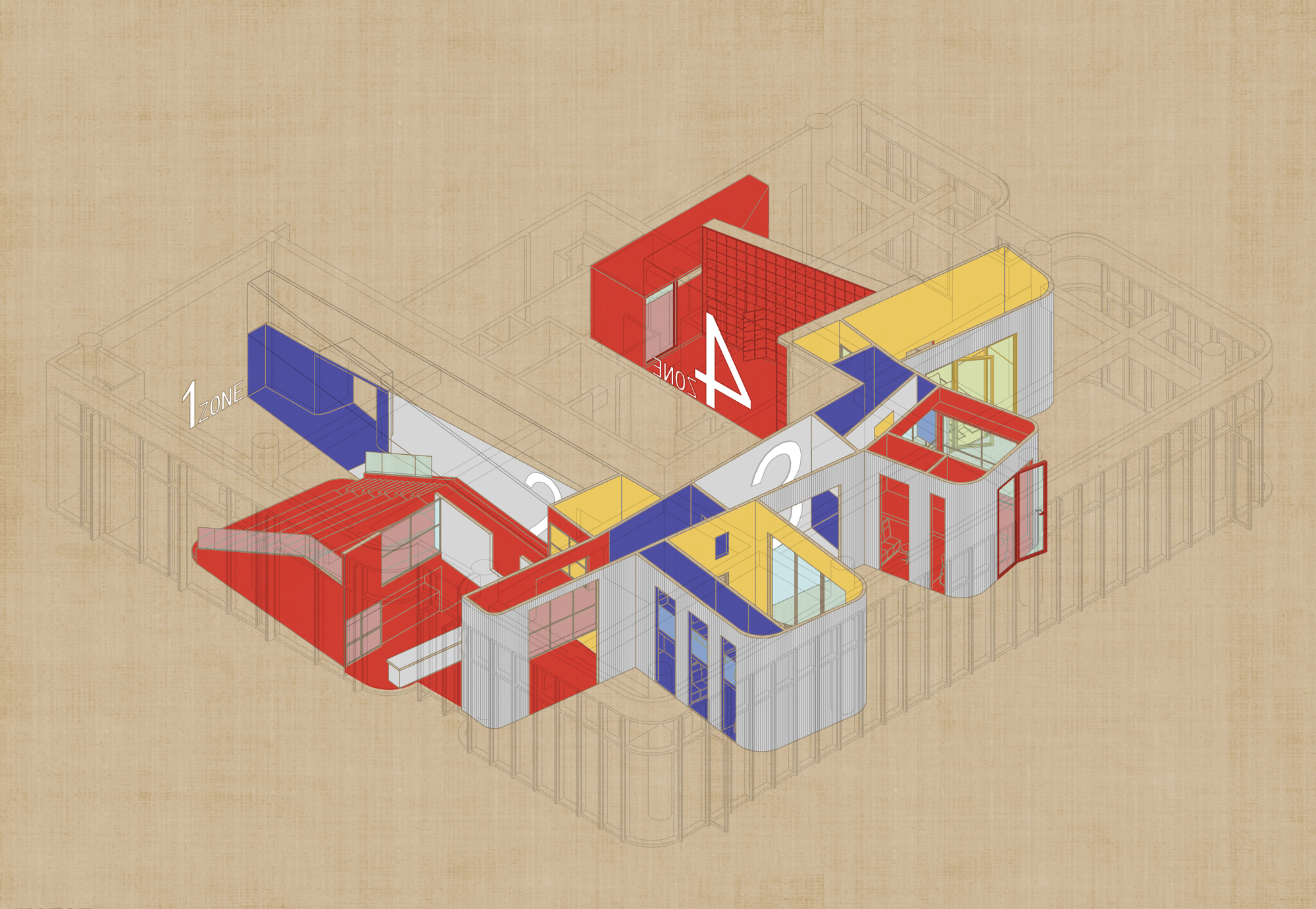
在这一项目中,我们希望打破常态化办公空间,创造一种未来式的整体性开放格局,让多个维度的空间可以在此交互,让人可以充分参与到对空间的感知中。我们设想了一种以“感知”和“探索”为核心的空间系统,从尺度感知、行为感知、色彩感知、序列感知和多维感知为核心,建立具有多元探索的全新办公模式。
According to the cultural attributes of the CAS Capital Digital Economy Innovation Center, we want to go beyond the standard office space pattern and create a new open system, allowing multiple dimensions of space to interact here, and allowing people can get fully immersive experience of the place we created. We materialize this spatial system with two main concepts: "perception" and "exploration", which is a new explorable model for today's offices from the perception of scale, perception of behavior, perception of color, perception of order and multidimensional perception as well.
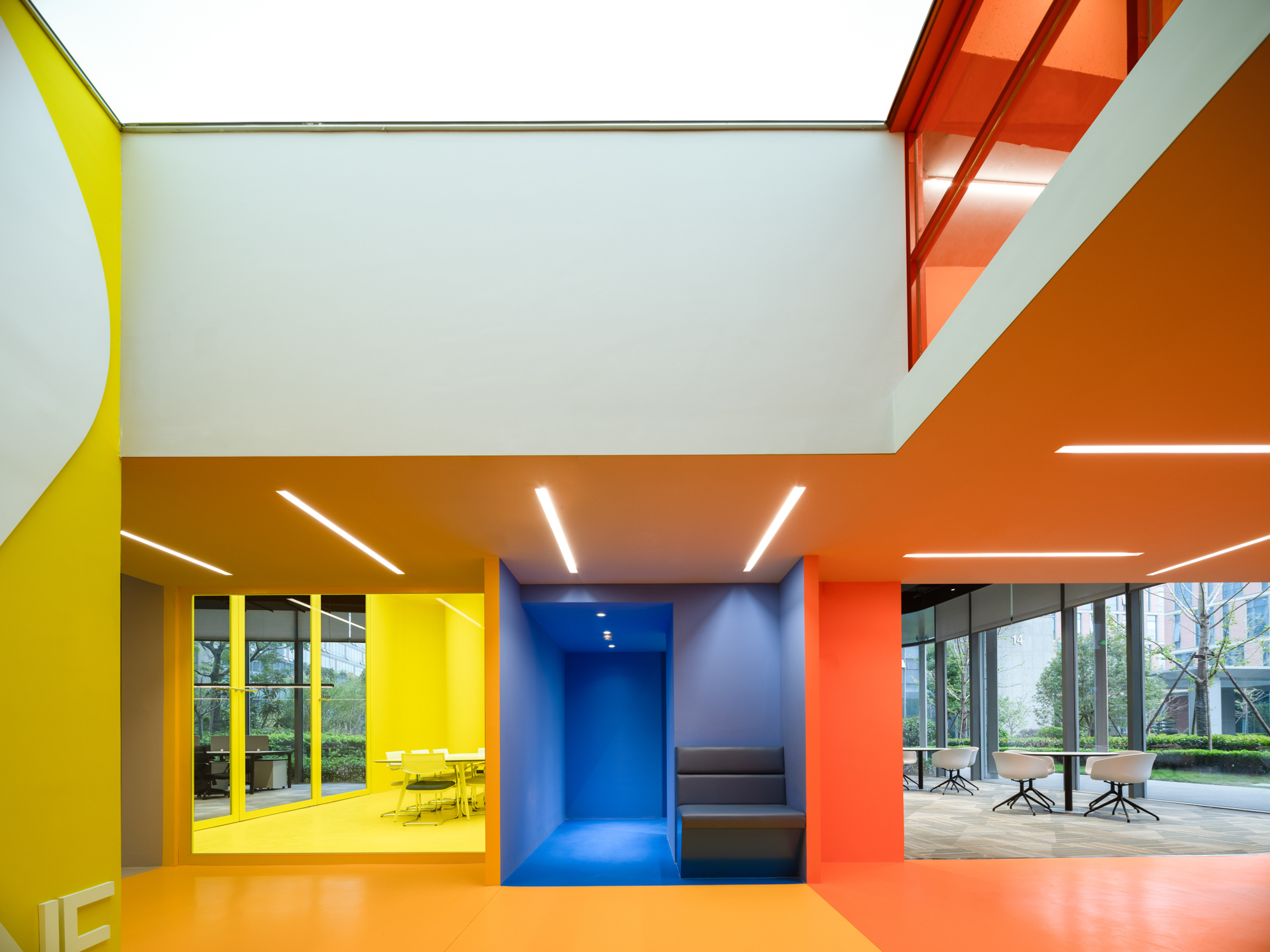
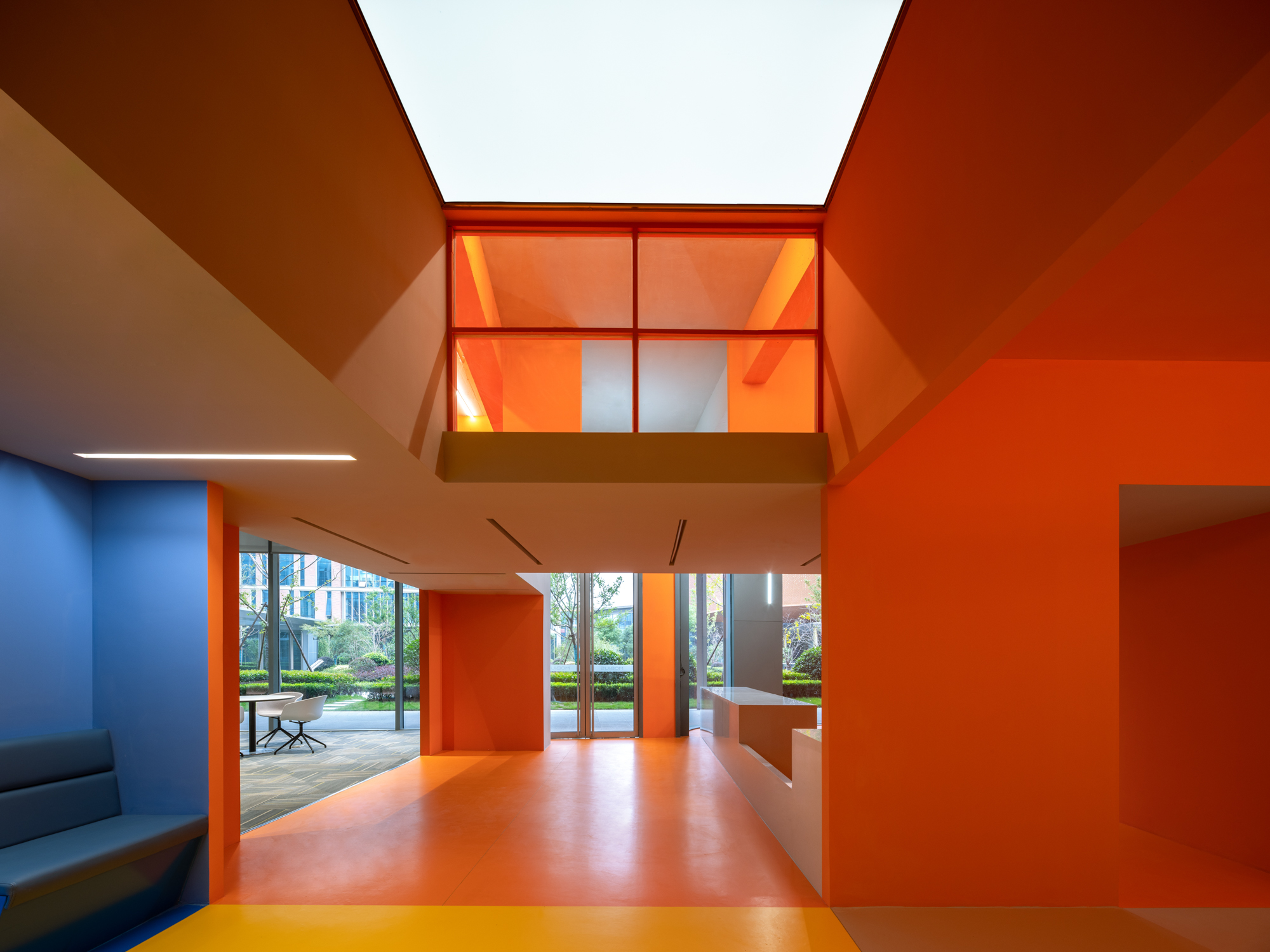
我们去掉了原有建筑中围绕着核心筒的廊道空间,打破了原有建筑格局的正交体系,置入了一系列错置的建筑盒体,这些盒体是一些拥有弧形转角的建筑体,我们希望这些倒角盒体可以形成一种连续的建筑立面;另外一方面,也希望这些弧形的体积可以与原有的弧形转角形成一种隔空对话,与建筑形成一种和谐共生的状态。
We eliminated the corridor space surrounding the central tube in the original building, broke the old gridding system, and replaced a series of boxes. These boxes are like buildings with curved corners that can form a continuous facade, also that can dialogue with the curved corners of this original space. That forms a harmonious symbiosis with this original space.
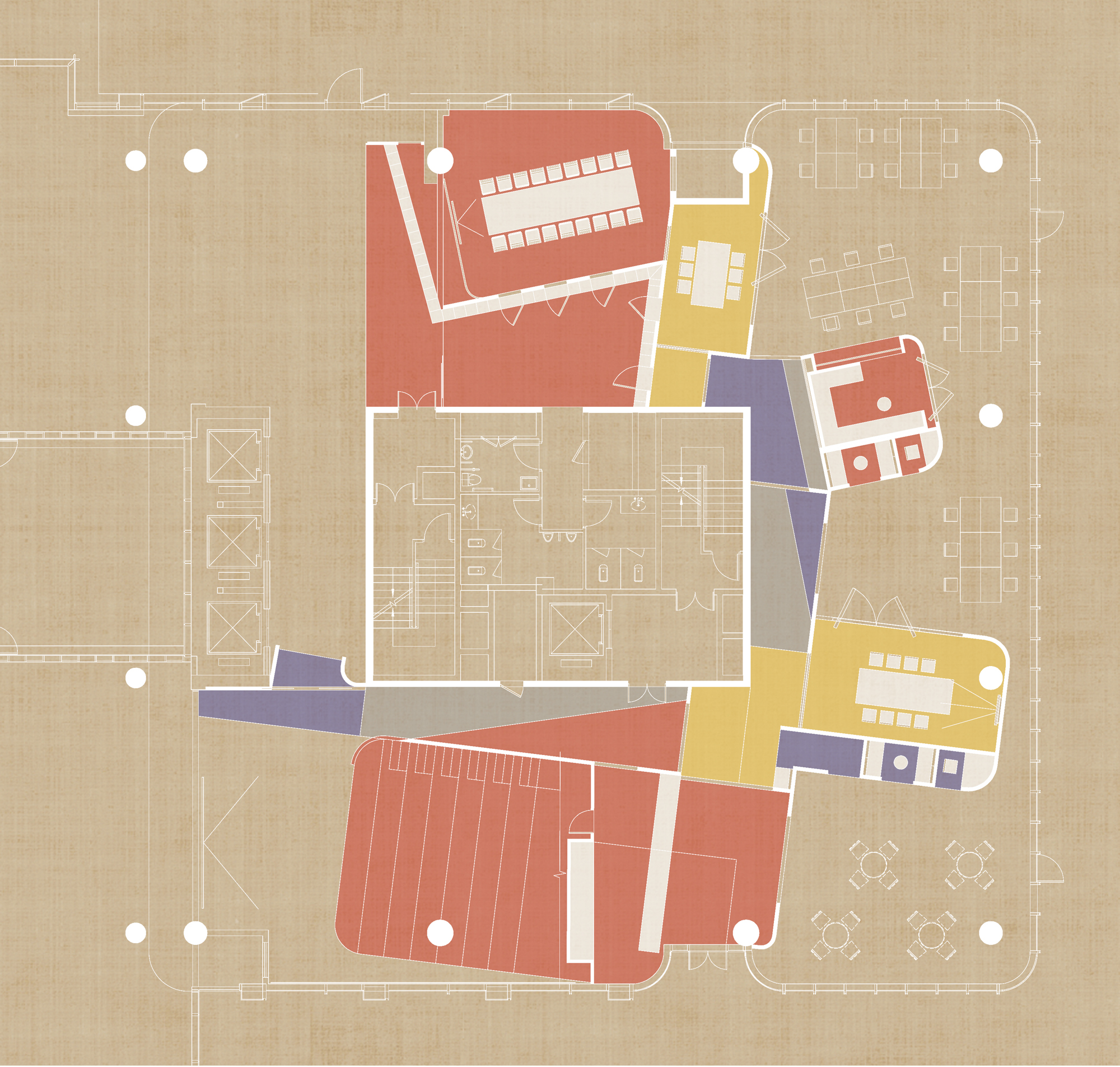
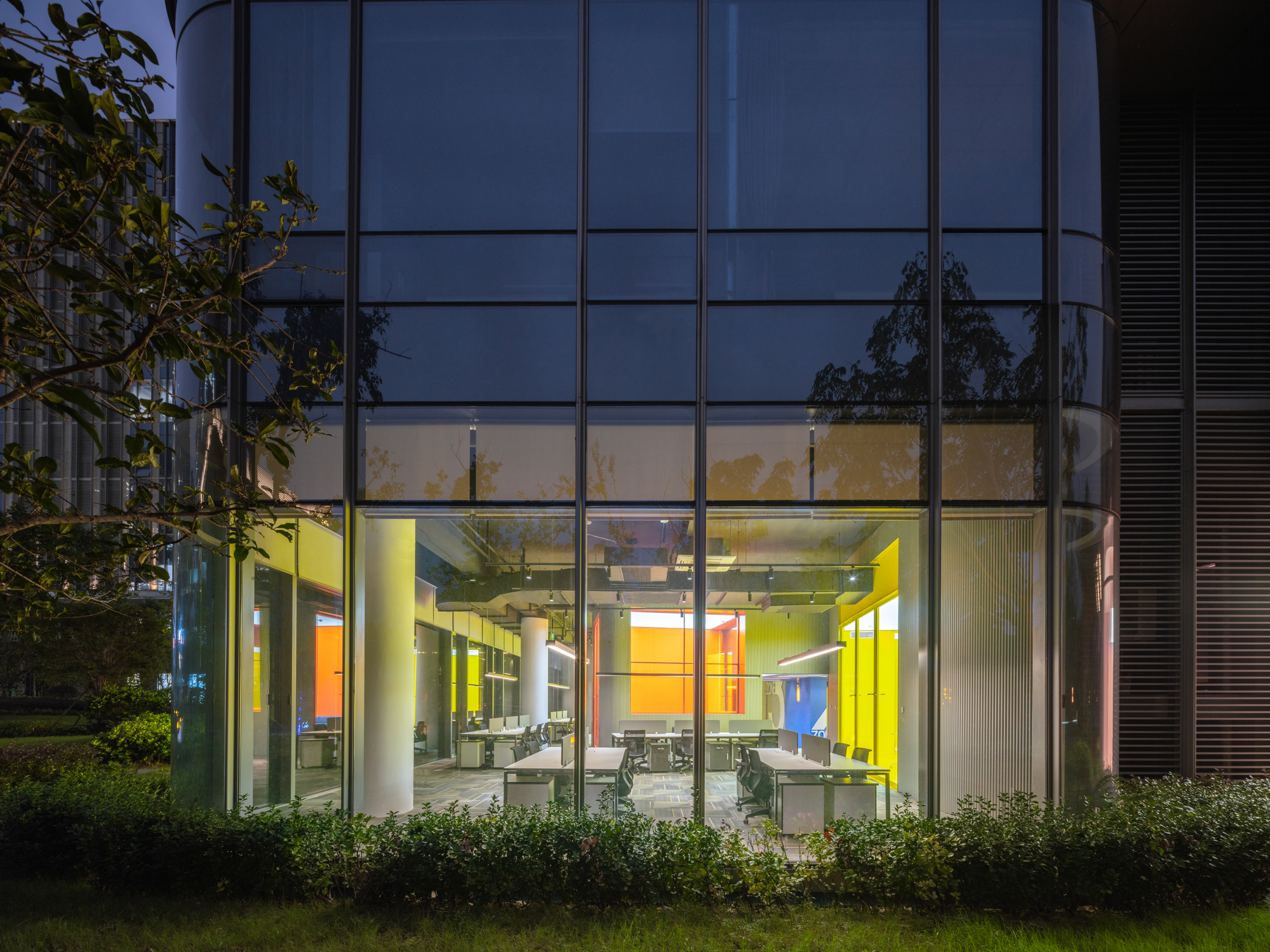
这些盒体被定义为一种“建筑内的建筑”,承担了这个迷你城市生态中的公共功能:会议室、洽谈室、路演剧场舞台、个人创作空间等。它们作为这个城市中共享式的“浮岛”,所有“浮岛”的外墙面使用建筑外墙中常用的波纹铝板,这为剩下的“海域”——室内办公空间提供颇具意味的室外氛围。
These boxes are defined as a kind of "buildings within buildings", which exist as public functions in this mini-city ecology: meeting rooms, negotiation rooms, roadshow theater stages, personal creation spaces, and so on. They serve as shared "floating islands" in this city. The outer walls of all "floating islands" use corrugated aluminum panels commonly used in building exterior walls. This provides a meaningful interior space for the remaining "sea area"-office space. The outdoor atmosphere.
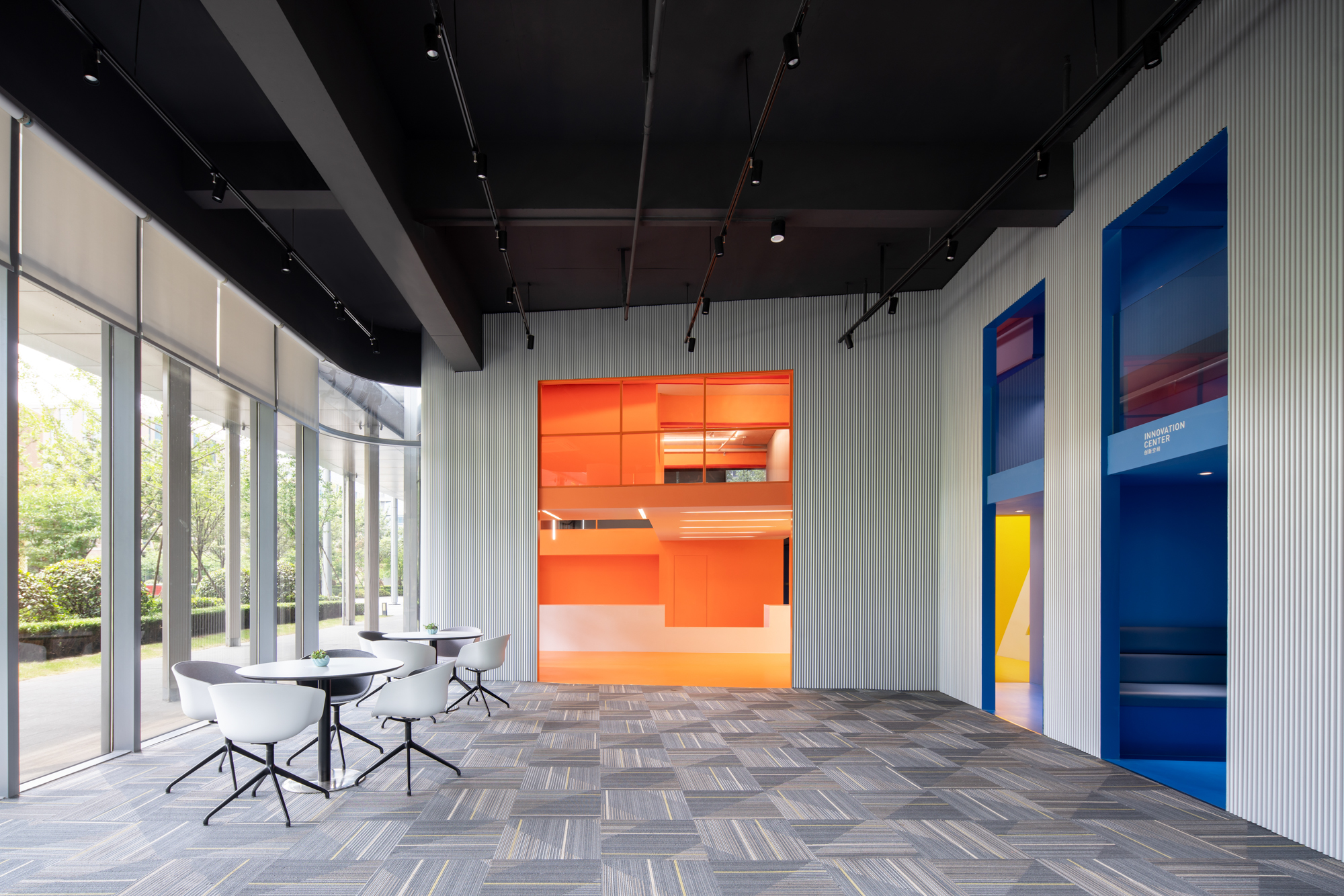
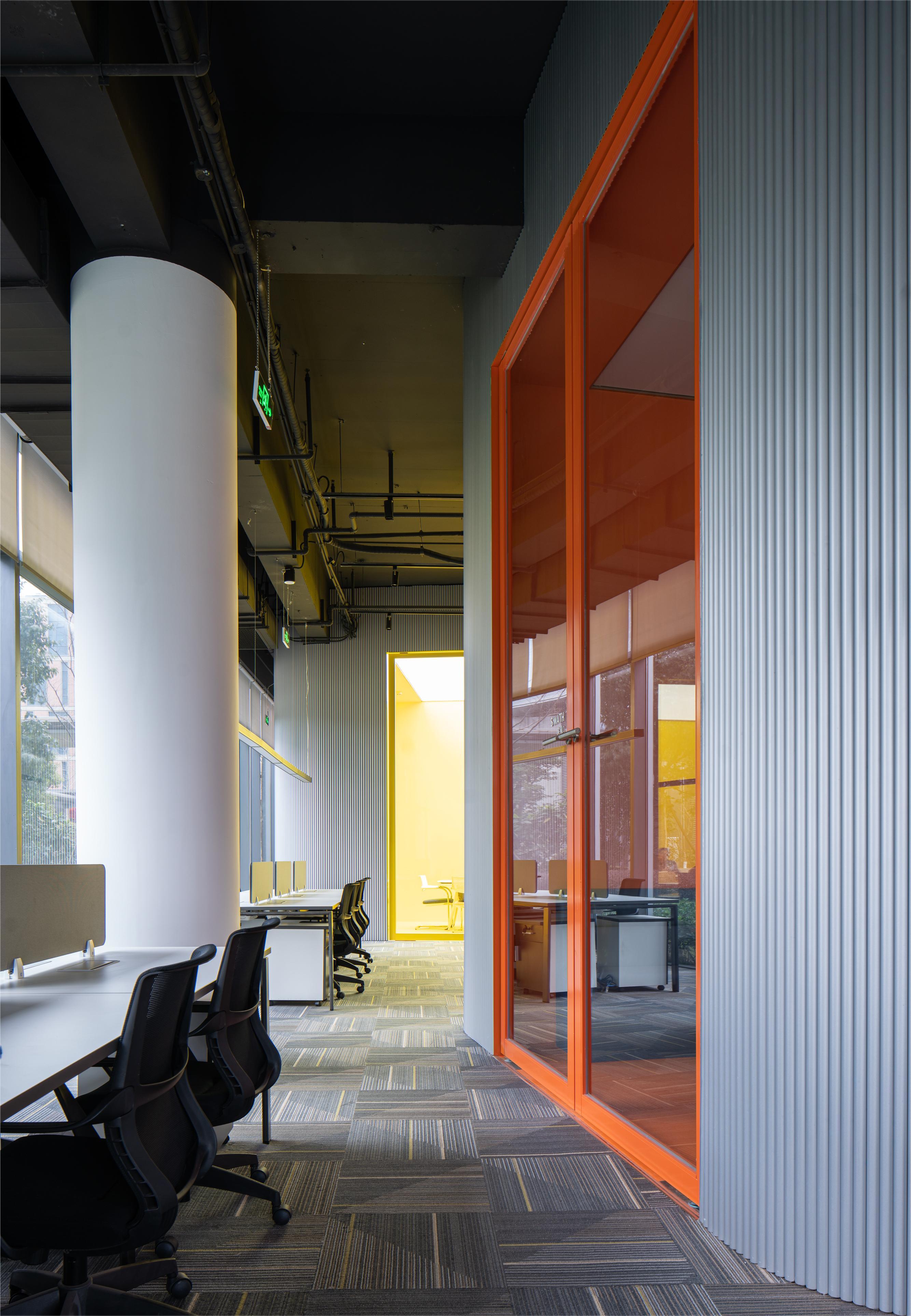
尺度的感知
我们调动的第一种感知是人对尺度的感知,我们有意地完成了一种连续的“城市立面”, 这些内化了的“城市立面”,是由门、窗等具有极强象征意义的建筑构件组成。它们对于空间的内在意义和属性具有重要的标识性作用,是一系列被抽象和异化了的具有明确语义的符号。
In the mobilization of scale perception, we have deliberately completed a continuous "internalized urban facade", these facades have doors, windows, and other architectural components with strong symbolic significance, and their internal significance to the space And attributes have an important identifying function. They are a series of abstract and alienated symbols with clear semantics.
在这个空间中,所有门和窗的比例被有意地放大了一倍。而在空间中,身体是我们对于空间尺度的感知的一个恒定标尺,对于“大”或是“小”的定义往往都是相较于我们自己的身体而言。因此人身处或是面对这一巨构空间时,会得到一种超越人日常经验的尺度感知,人身体上对于空间尺度的感知力以及精神上对于符号意涵的读解力,都被充分地调动了起来。
In this space, the ratio of all doors and windows has been deliberately doubled. People’s perception of the spatial scale has a constant scale—the body. Our definition of “big” or “small” is often compared to our own body, so people are in or face this When building a huge space, you will feel an unusual sense of oppression, which completely surpasses the understanding of scale in people's daily experience. Therefore, the human body's perception of the spatial scale and the mental understanding of the meaning of symbols have been fully mobilized.

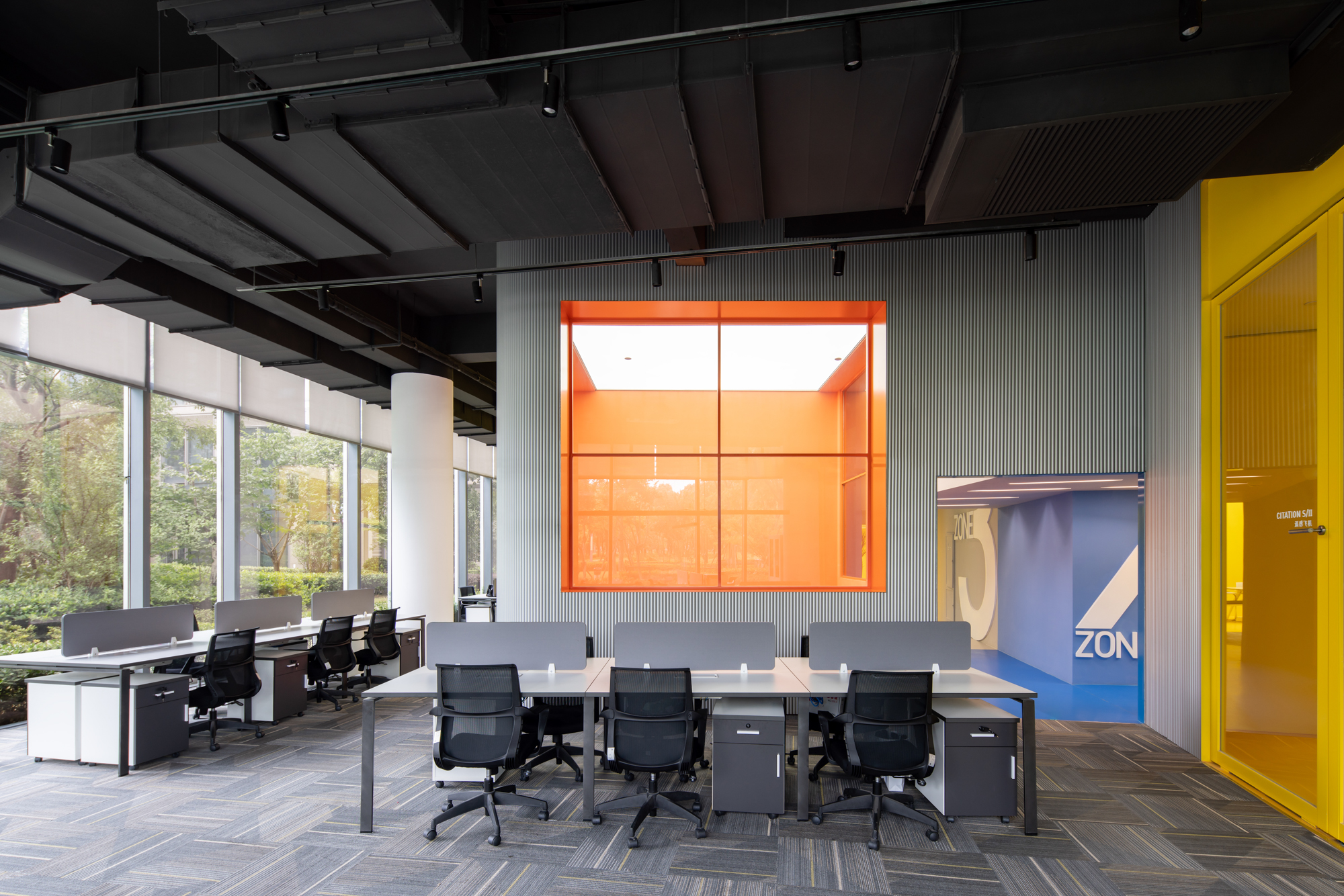

与巨构尺度同时存在的是极小尺度。我们设立的个微创作空间是一种极小的迷你空间, 它的尺度是最贴合个体的极限尺度,也是服务于个体的庇护所。它既可以容纳一个人安静思考或创作,也可以适合两个人的私密会谈。
At the same time, our mobilization of scale perception is two-level, one pole is a super-scale megastructure, and the other pole is an individualized microstructure. In the personal subtle creation space we set up, it is a mini space of only 2mx2m, which can be used as a refuge for one's quiet thinking and creation. In use, people will be surprised that such a small space can actually accommodate four people's conversations or meetings at the same time.
我们对于这一空间尺度的感知正是在这极大与极小之间不断地转换,最大化地调动和刺激人身体对于空间体积的感知力。这种全新的尺度构建方式更像是一种宣言:打破意识中固化的范式,用身体本真地去探索未知,去探索另一番的世界。
Our perception of this spatial scale is constantly switching between this maximum and minimum, maximizing the mobilization and stimulation of the human body's perception of the volume of space. This new way of constructing scales is more like a declaration: breaking the solidified paradigm in consciousness, using the body to explore unknown scales and exploring another world.


行为的感知
我们调动的第二层感知是人行为的感知。整个展厅的入口区域被定义为一个纯粹的探索区域,由三面围合的均质柜体构成。在初进入这个矩阵式的柜体空间时,每个参观者都是疑惑的,入口需要通过自己动手去寻找。在整个过程中,人都会保持着一种未知状态,这是对整个空间“探索”和“感知”的开始。每一次的开启中,参观者不知道他将打开的是一个小格子,还是一扇门,又或是一扇窗。
The second perception we mobilize is the perception of human behavior. The entrance area of the entire exhibition hall is defined as a pure exploration area. This exploration area is composed of a homogeneous cabinet enclosed on three sides. At the beginning, we entered this matrix cabinet. In the physical space, every visitor is puzzled. The entrance needs to be searched by oneself. During the whole process, people will remain in an unknown state. This is the beginning of the "exploration" and "perception" of the entire space. In each opening, the visitor does not know whether he will open a small grid, a door, or a window.
在其他的部分中,门、窗这些构件是被最大化地凸显和强调的,而在这一空间中则正好相反,被最大化地隐藏和同化了起来。我们希望它可以指向门与窗的本质状态——它们都是连接空间的介质,是一种空间连接的中介,而“打开”则是给予它语义的一个重要行为。
In other parts, the components such as doors and windows are maximized and emphasized, but in this space, on the contrary, they are maximized and hidden. We hope that it can point to the essential state of doors and windows-they are both a medium connecting space, a medium connecting space, and "opening" is an important behavior that gives it semantics.
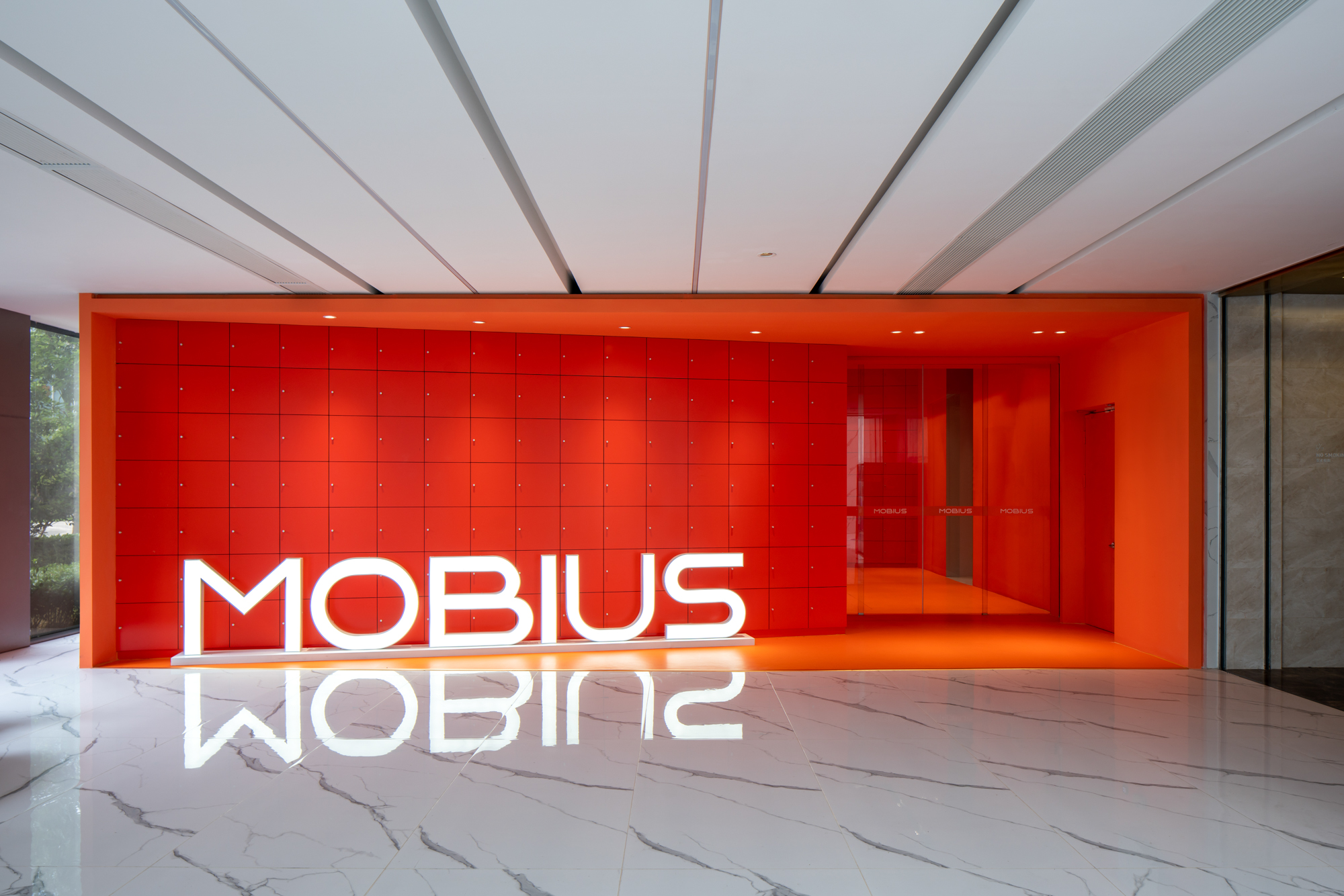
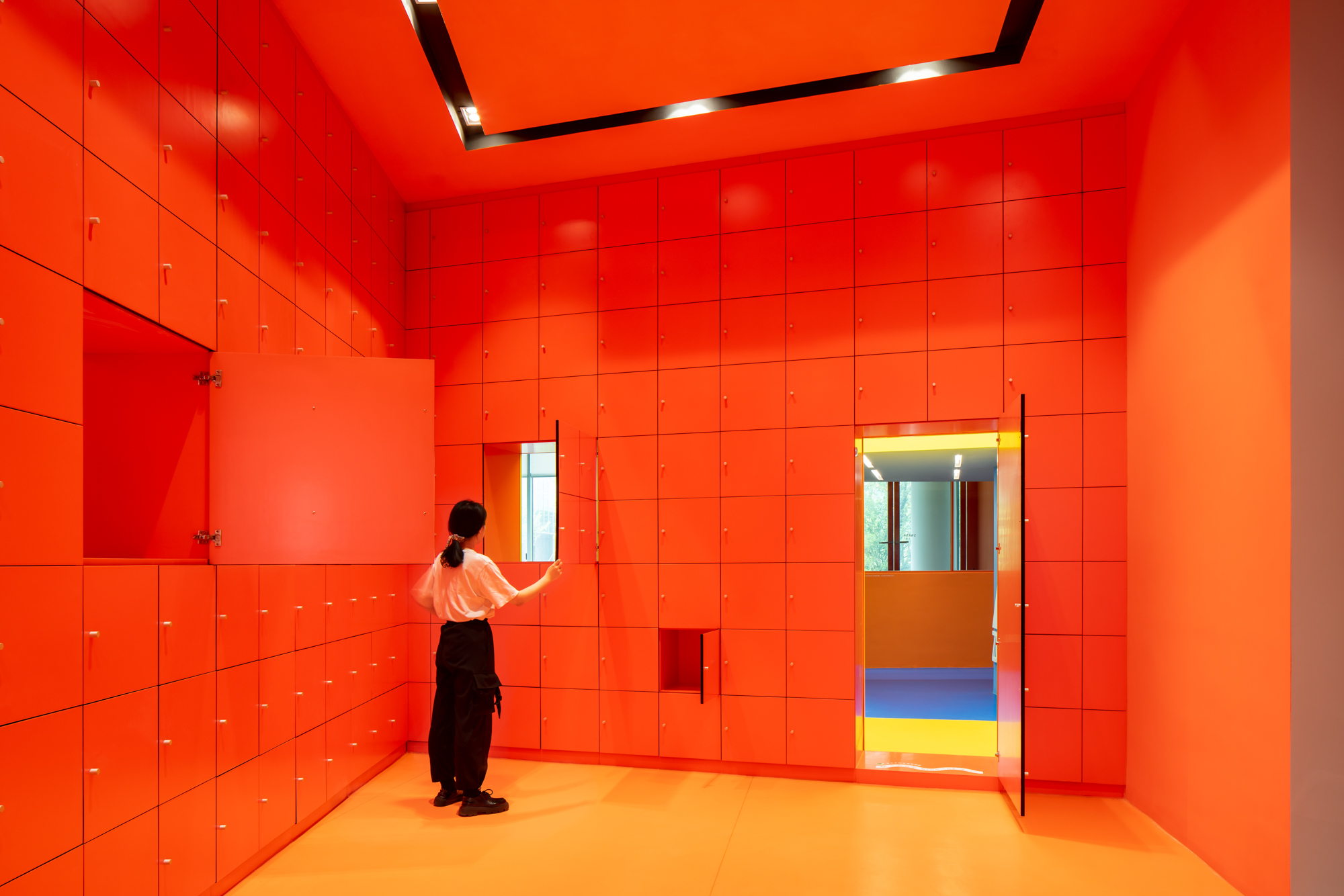
当我们打开柜体进入这个空间以后,行为的感知力被不断地延续着,使用者会遇到一些被拉高到两倍之后的门体,这些门把手高度也随之提高到一米五的高度,这时人打开的行为也随之变化,身高较矮的甚至需要抬起手臂才能打开,这时“打开”又将行为的感知与尺度的感知交融在了一起。
When we open the cabinet and enter this space, the perception of behavior is still continued. When some doors are doubled, the height of the door handle also increases to a height of 1.6 meters, then the person opens The behavior of the person who is shorter also needs to be lifted to open. At this time, “opening” blends the perception of behavior with the perception of scale.
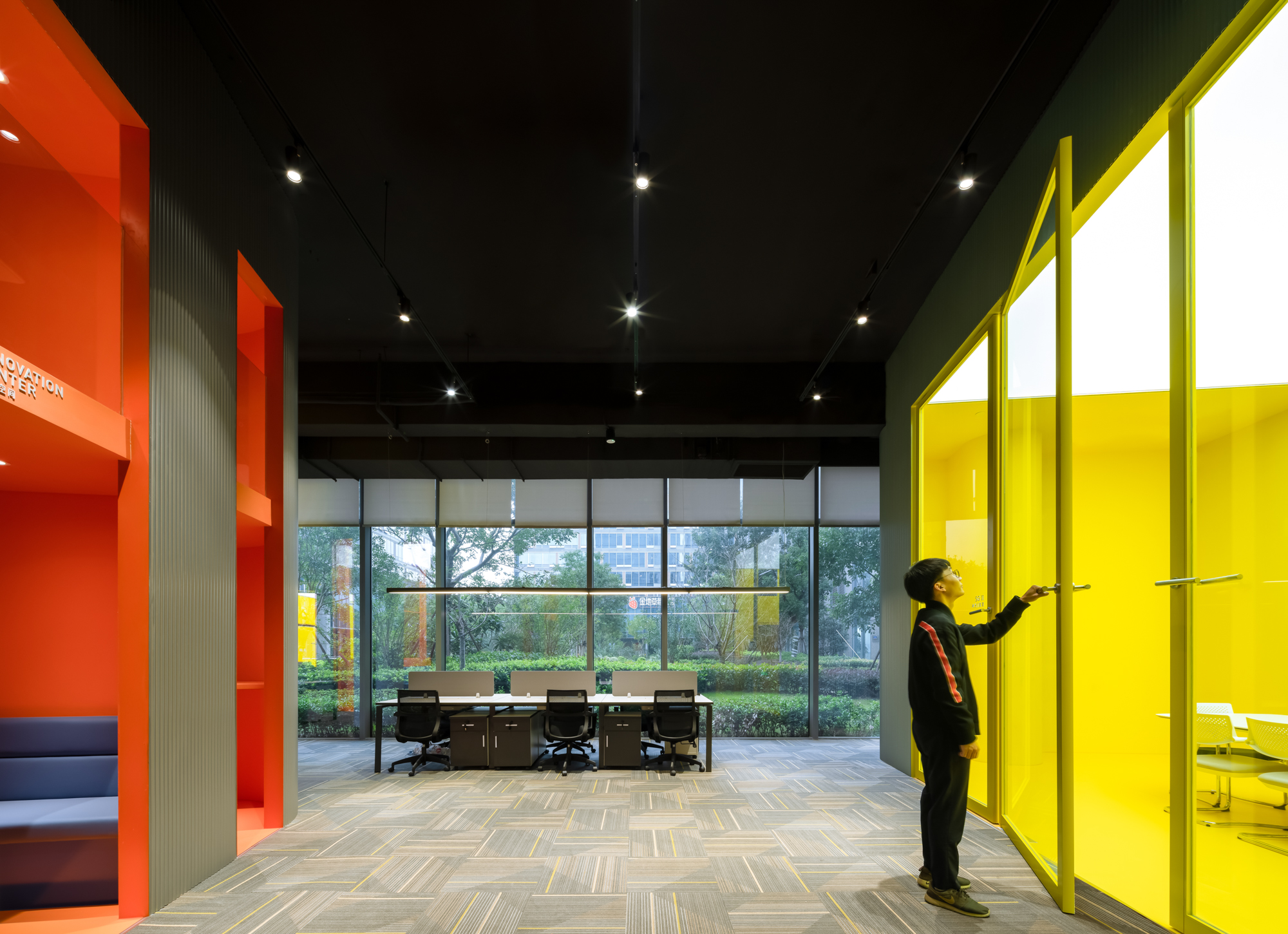

序列的感知
我们调动的第三种感知是人对序列的感知。当使用者处在非正交的空间中时,原本稳定的空间坐标轴被打乱,空间的转折、扭转都模糊了人对空间范式化的感知,转而进入一种感性的、沉浸式的剧场化感知中。
The third perception we mobilize is the perception of sequences. When the user is in a non-orthogonal space, the originally stable space coordinate axis is disrupted, and the turning and torsion of the space blurs people's perception of the actual scale of the space, and in turn, enters a state of perception of the scale.
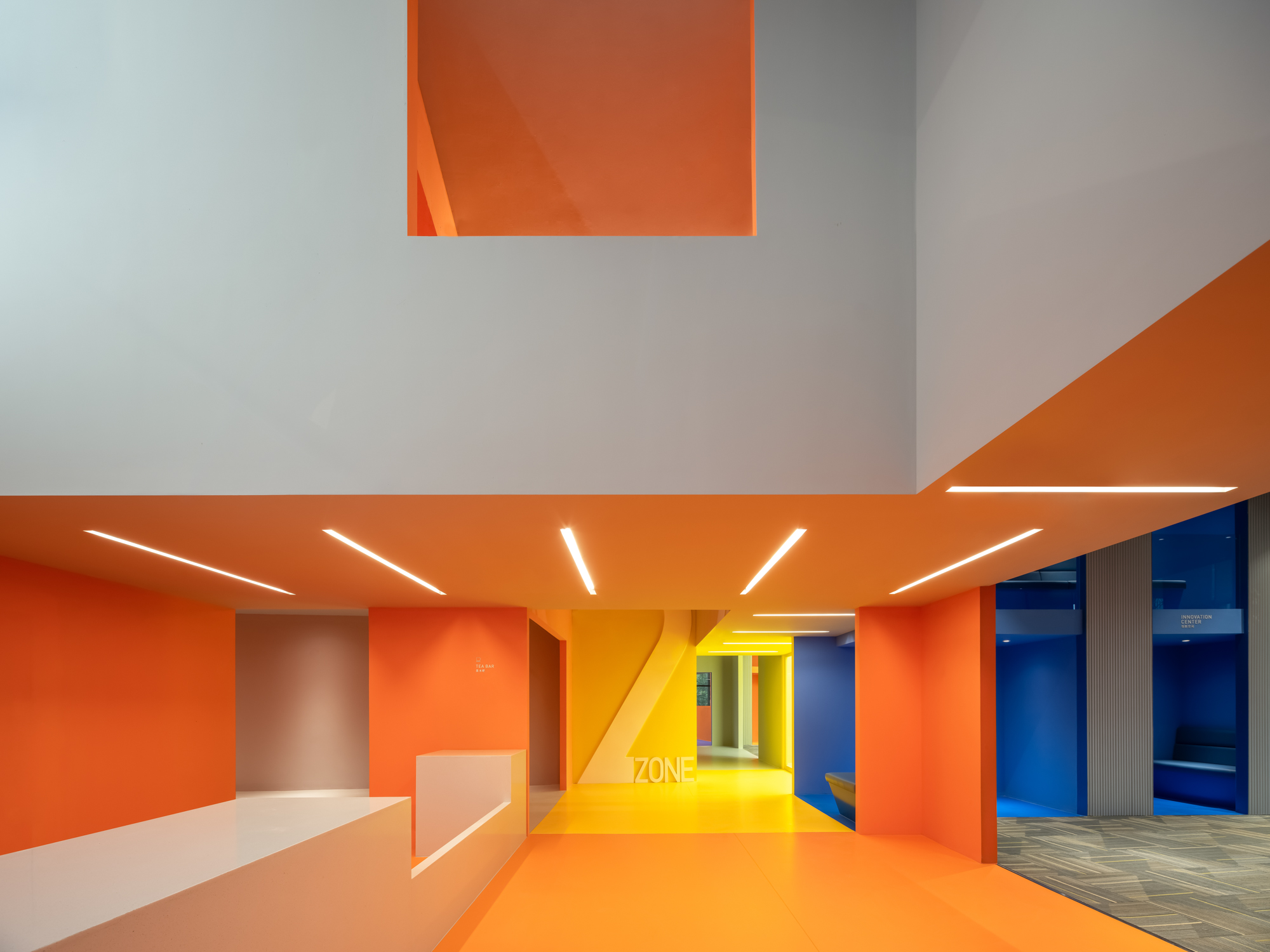
因而在这些模糊的空间中,我们特地设置了一些“标尺”,这些“标尺”给予了空间“可解读性”。比如阵列的柜体空间,所有柜体有着统一的尺度,它们好似空间的辅助线,让空间在需要时可以被度量;同时灯管的有序排列也形成了一种“标尺”;连续的波纹铝板也是一种序列,它作为一种规律性的材料,有着自身确定的材料间距。
Therefore, in these fuzzy spaces, we have specially set up some "rulers", which give the space "interpretability". For example, the cabinet space of the array, all cabinets have a uniform scale, they are like auxiliary lines of the space, so that the space can be measured when needed; at the same time, the orderly arrangement of the lamps also forms a kind of "ruler"; Corrugated aluminum plate is also a sequence, as a regular material, it has its own determined material spacing.
另外一些材料则是完全不可度量的,比如整面的乳胶漆涂料和没有分缝的地胶板,因为缺少参照物,它的尺度则是模糊的。因此,这一空间中的材料被清晰地分为了两种,一种是具有明确序列感的“标尺”,一种是极致模糊的不可度量的材料,而使用者则是在可度量和不可度量间不断地进行转换。
Other materials are completely immeasurable, such as the entire surface of latex paint, and the floor plank without joints. Because of the lack of reference, its scale is blurred. Therefore, the materials in this space are clearly divided into two types, one is a "ruler" with a clear sense of sequence, the other is an extremely vague and unmeasured material, and the user is measurable and unmeasured. Continuously switch between.

维度的探索
我们调动的第四种感知是人对空间维度的感知。我们希望描述的这个空间,它不只是由空气填塞满的盒子,还能有着多重维度的意义。在大部分生活中,我们体验到的空间都是单一维度的,而一个空间实际上是有着横向、纵向,包括垂直或是对角等多种维度上的层级。因此当我们位于任何一个层级去观察这一空间,都会得到不同的感知结果,这种多维的读解让空间变得多元。
The fourth perception we mobilize is people's perception of spatial dimensions. The space we hope to describe is not just a box filled with air, it also has multiple dimensions. In most of our lives, the space we experience is a single dimension, and a space actually has multiple levels of horizontal, vertical, vertical, or diagonal. Therefore, when we observe this space at any level, we will get different perceptual results. This multi-dimensional interpretation makes the space more diverse.
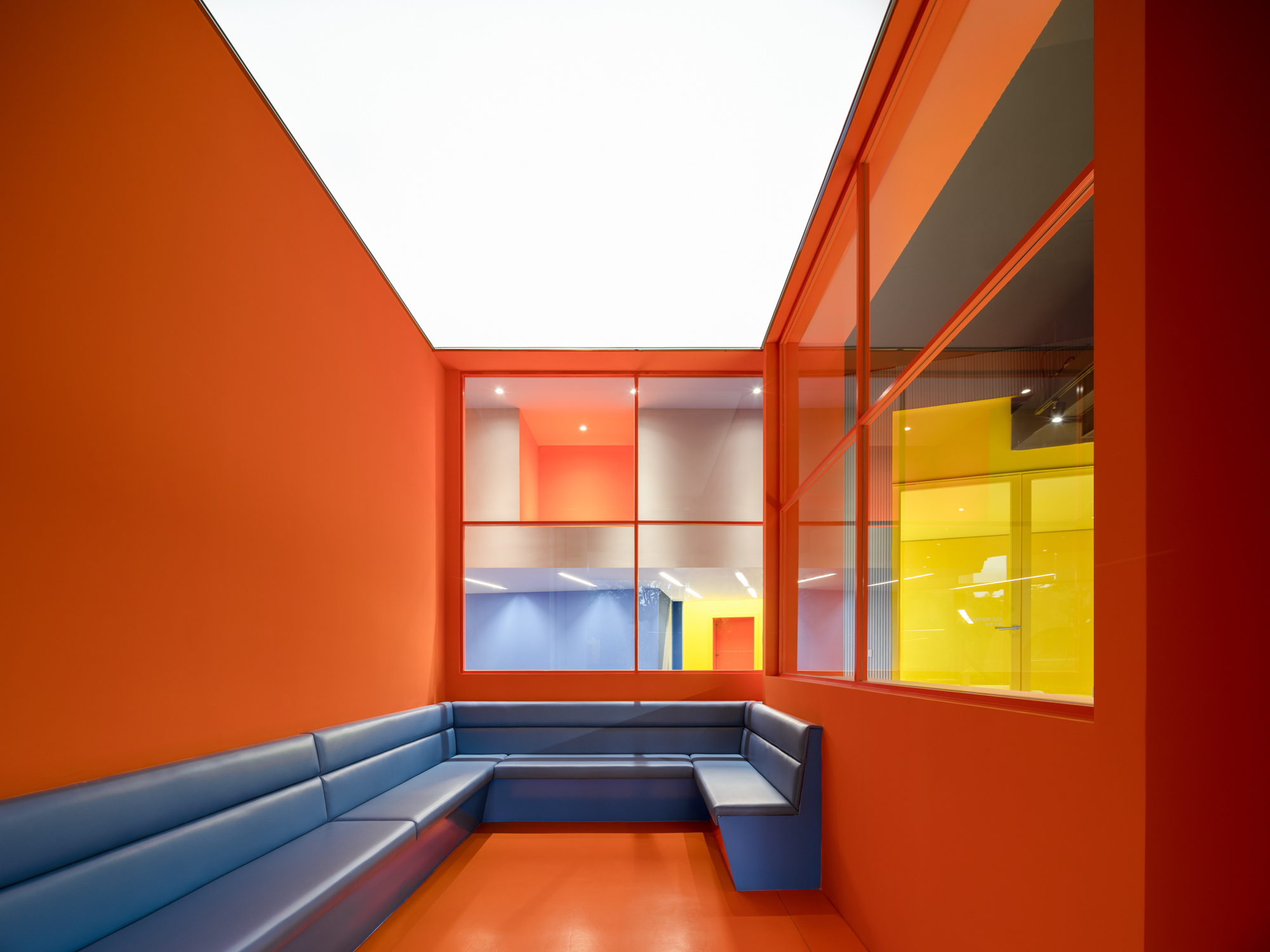
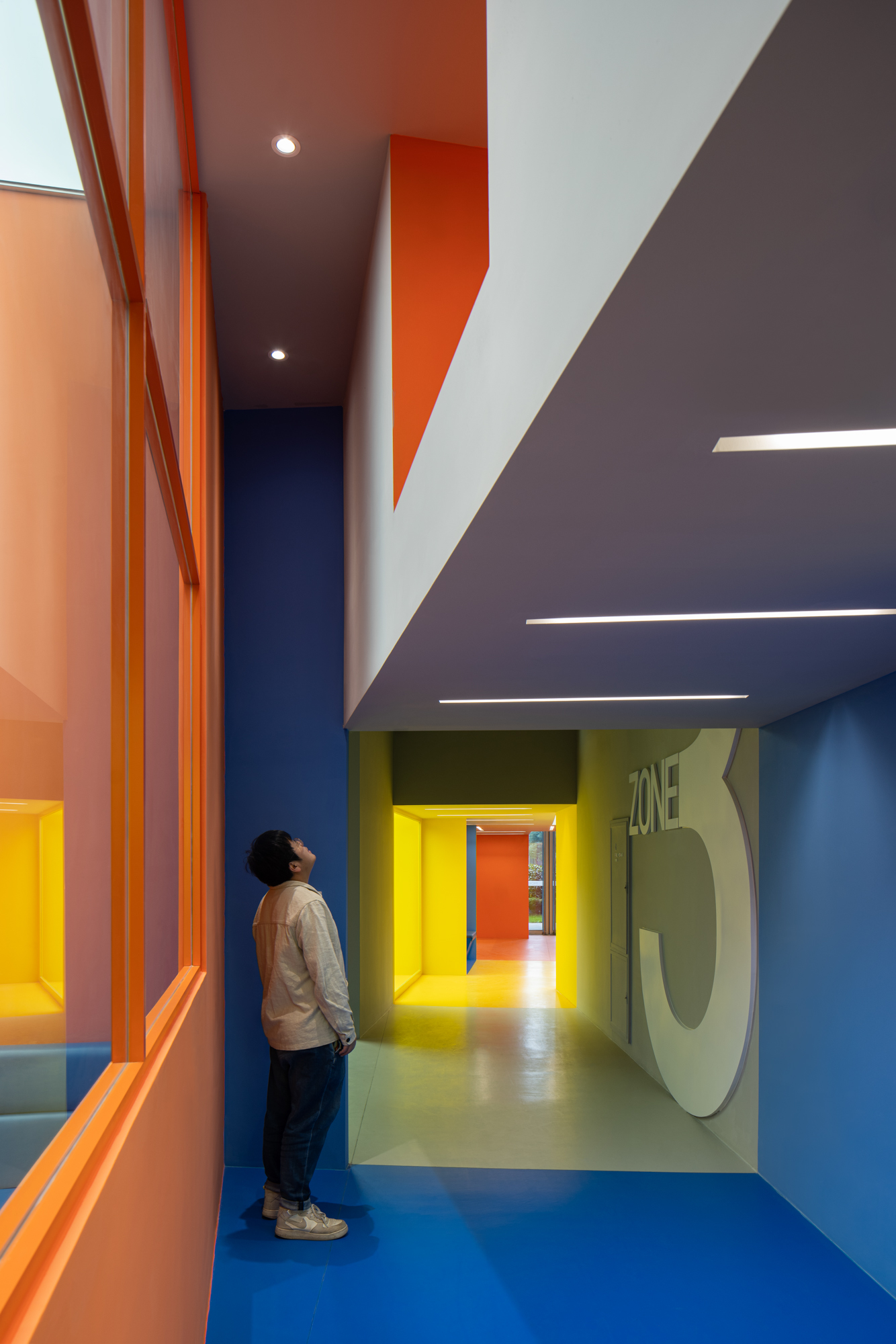
这正需要我们充分调动每一个空间在多个方向上的潜力。我们需要给每一个空间都设立至少两种以上的观看方式:有时我们的观察顺从于我们进入空间的方式;有时需后退拉开距离远眺;有时则是不经意间的回望;甚至有时一个墙体的两面都有着巨大的差异。我们希望使用者能深刻地感知到空间在多个维度间转化的过程,充分发挥这个空间的潜力。每一个空间都是一个正在发生的剧场,它的精彩程度取决于我们以哪种角度去看待它。
This requires us to fully mobilize the potential of each space in multiple directions. We need to set up two or more ways of viewing for each space: some viewpoints are parallel to the way of entering; some viewpoints need to retreat to another space for a distant view; some viewpoints are inadvertently looking back. We hope Users can deeply perceive the process of space transformation among multiple dimensions, and this is where the potential of space lies.
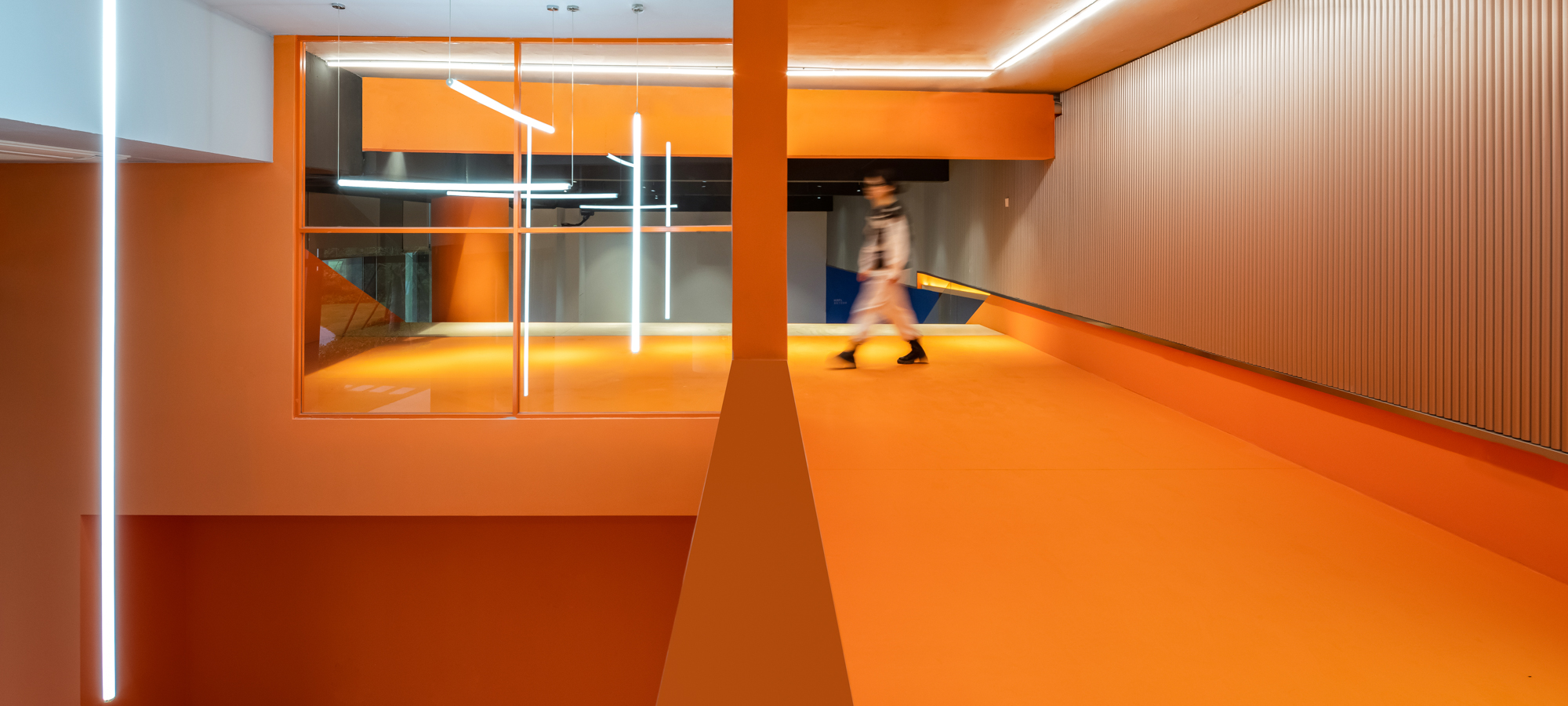
空间维度上的“陌生感”来自于当我们换一个角度观察这个片段的时候,我们经历了消失—跳跃—出现等一系列过程,而在回望中,却可以像破案一般,找到它们之间的线索和联系。因为当我们深入在空间当中的时候,对空间的感知往往是受限的。在另外一个视点回望观察过的地方,则会产生一种记忆的回溯,也产生了这种对熟悉场所的“陌生感”。“陌生感”让我们开始换一个角度看待空间,也同时换一个角度看待我们面对的很多问题。
The "stranger" in the spatial dimension comes from the fact that when we look at this clip from another angle, we have gone through a series of processes such as disappearing-jumping-appearing, but in looking back, we can find them like solving a case. Clues and connections between. Because when we are deep in space, our perception of space is often limited. Looking back at the place you have observed from another point of view will produce a kind of backtracking of memories, and this kind of "strangeness" of familiar places. The "stranger" makes us start to look at the space from another angle, and at the same time look at the many problems we face from another angle.
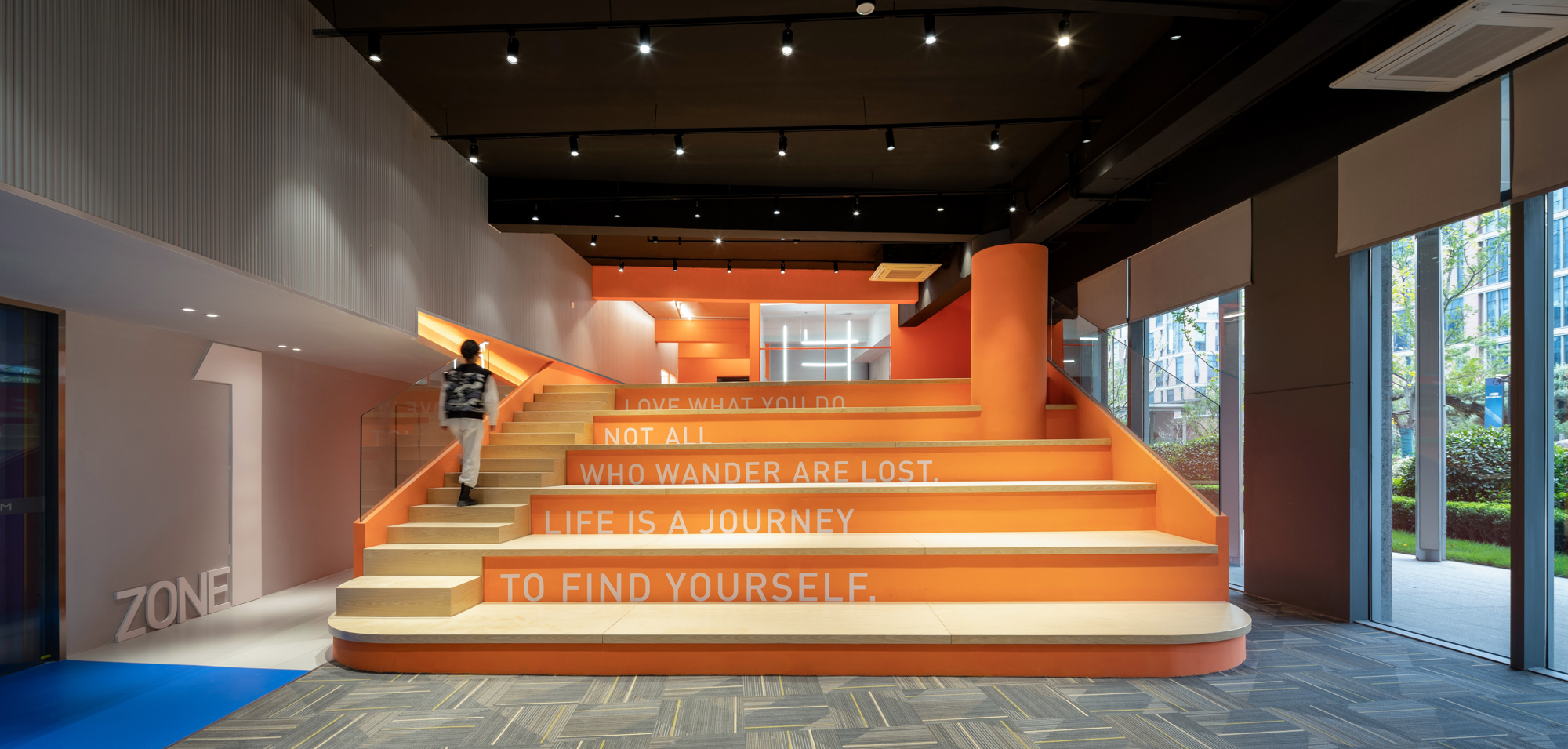
色彩的感知
我们调动的第五种感知是人对空间色彩的感知。单色空间,色彩是单一的,但空间是多维的,因此单一的颜色在空间中呈现的视觉状态并不单一,反而具有更强的对空间的塑造力。空间是动态的,色彩会在不同的光线环境下,也会随着人的观察视点的变化而变化,这些变化都最大化地增加了空间的可能性。
The fifth perception we mobilize is people's perception of the color of space. In the monochromatic space, the color is single, but the space is multi-dimensional. Therefore, the visual state of a single color in the space is not single, but has a stronger shaping power on the space. The space is dynamic, and the color will change under different light environments and with the change of people's observation point of view. These changes maximize the possibility of the space.
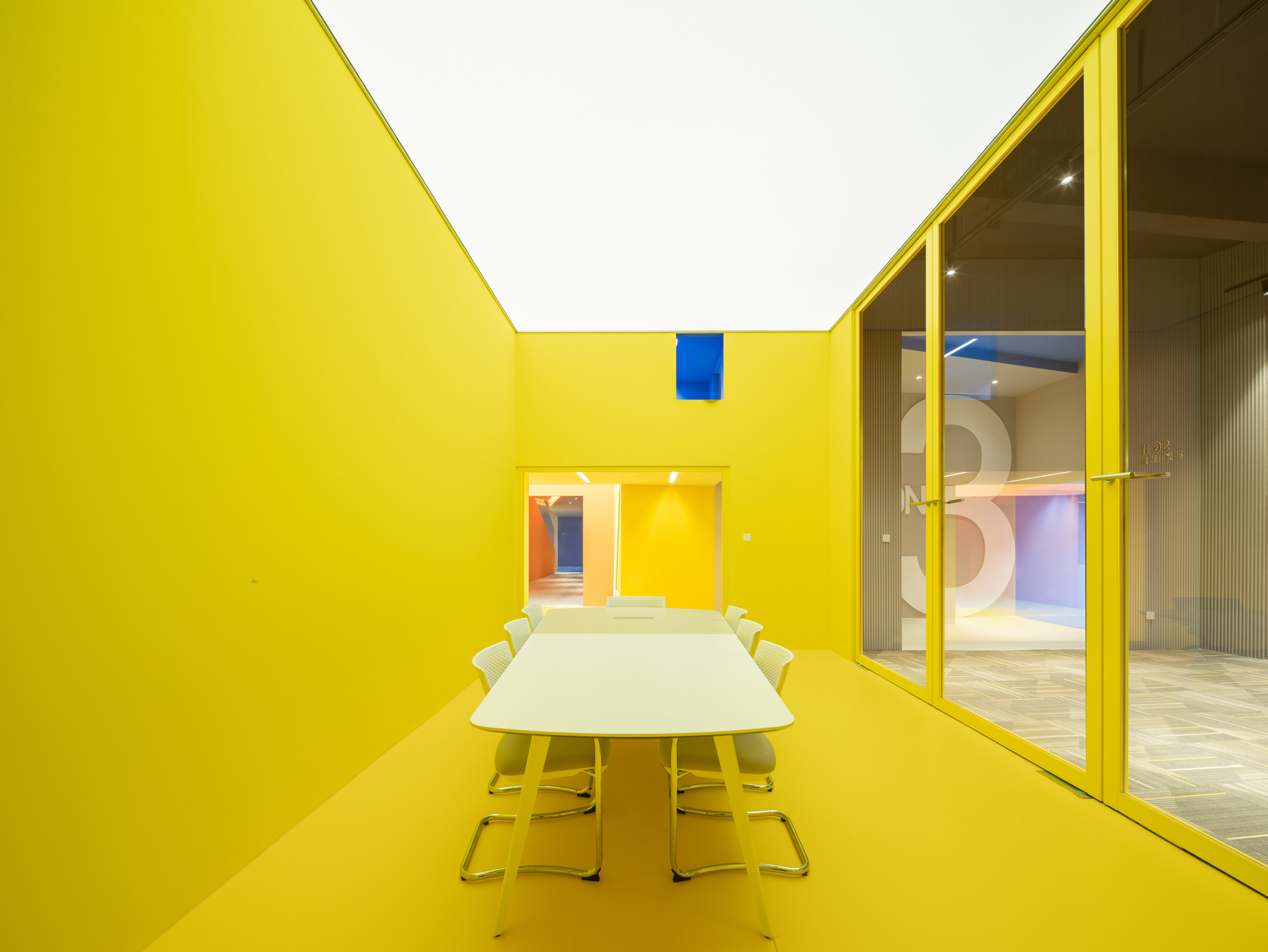
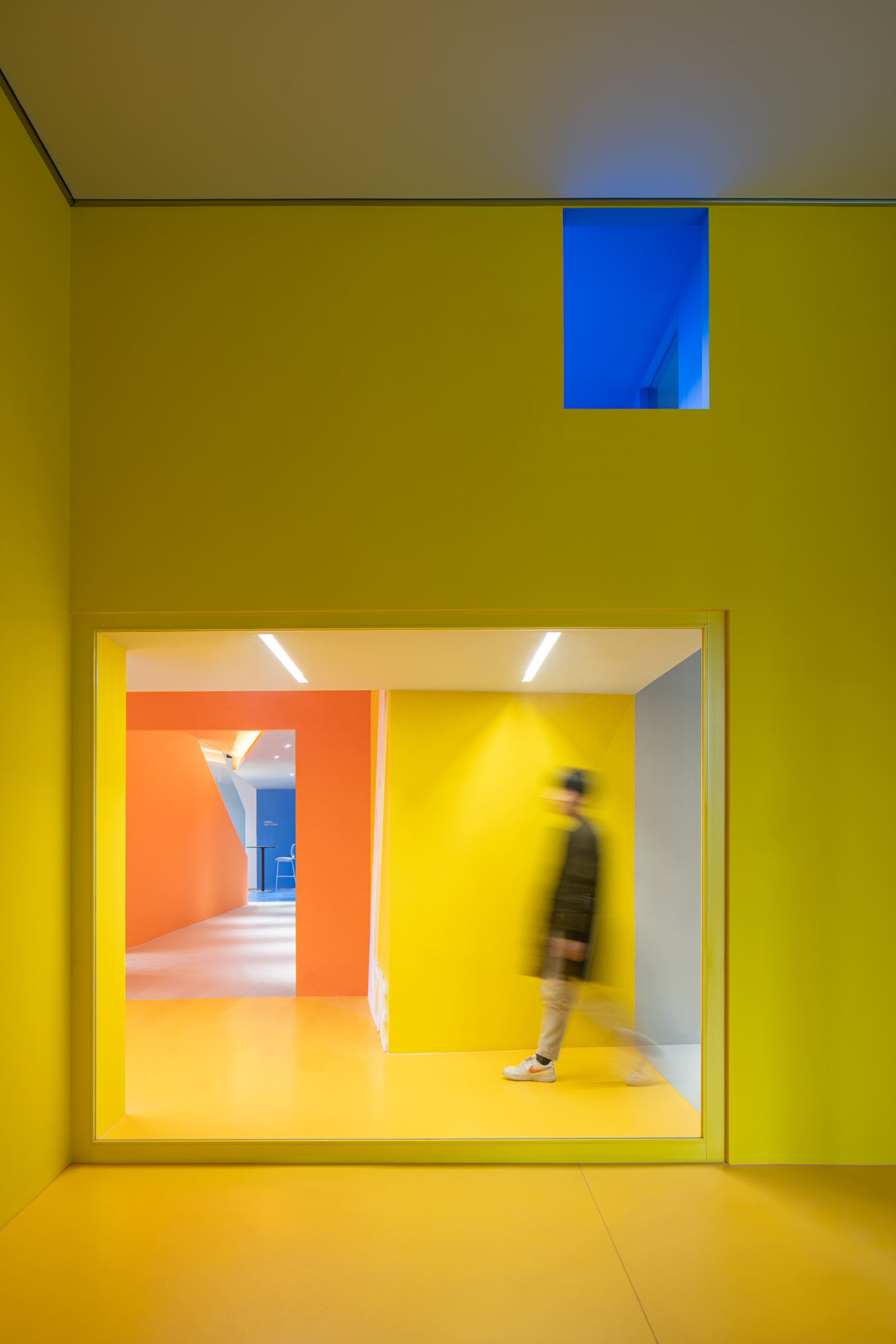
色彩之间的交接,也增加了一层对不同空间的定义,色彩延伸了某些空间的边界,物理边界开始和色彩边界重叠,这种重叠创造出了许多具有透明性的空间,从物理边界上属于走廊,但从色彩边界上归属于室内空间。
The transition between colors also adds a layer of definition of different spaces. Colors extend the boundaries of certain spaces. The physical boundaries begin to overlap with the color boundaries. This overlap creates many transparent spaces, starting from the physical boundaries. The upper part belongs to the corridor, but belongs to the indoor space from the color boundary.
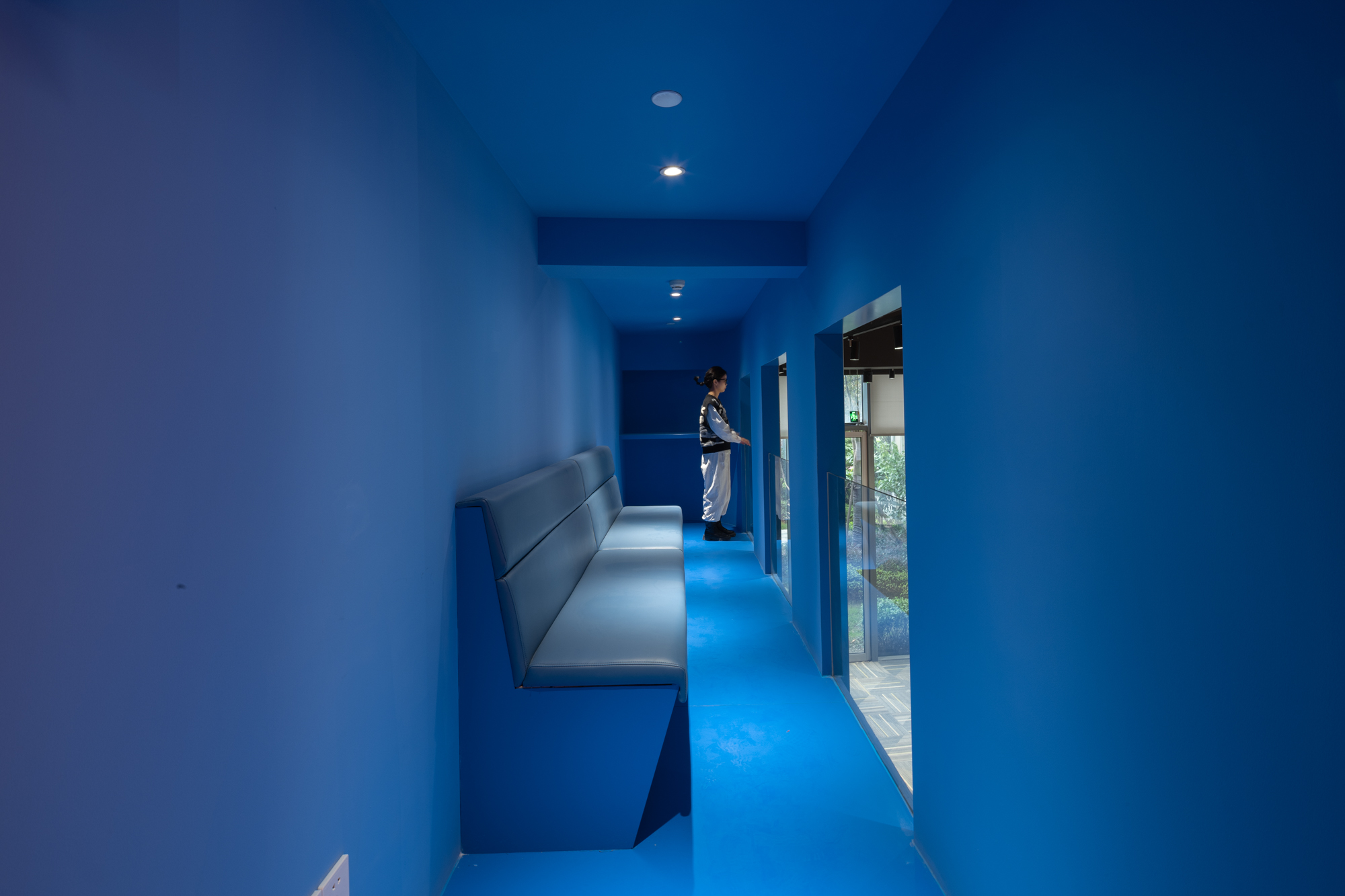
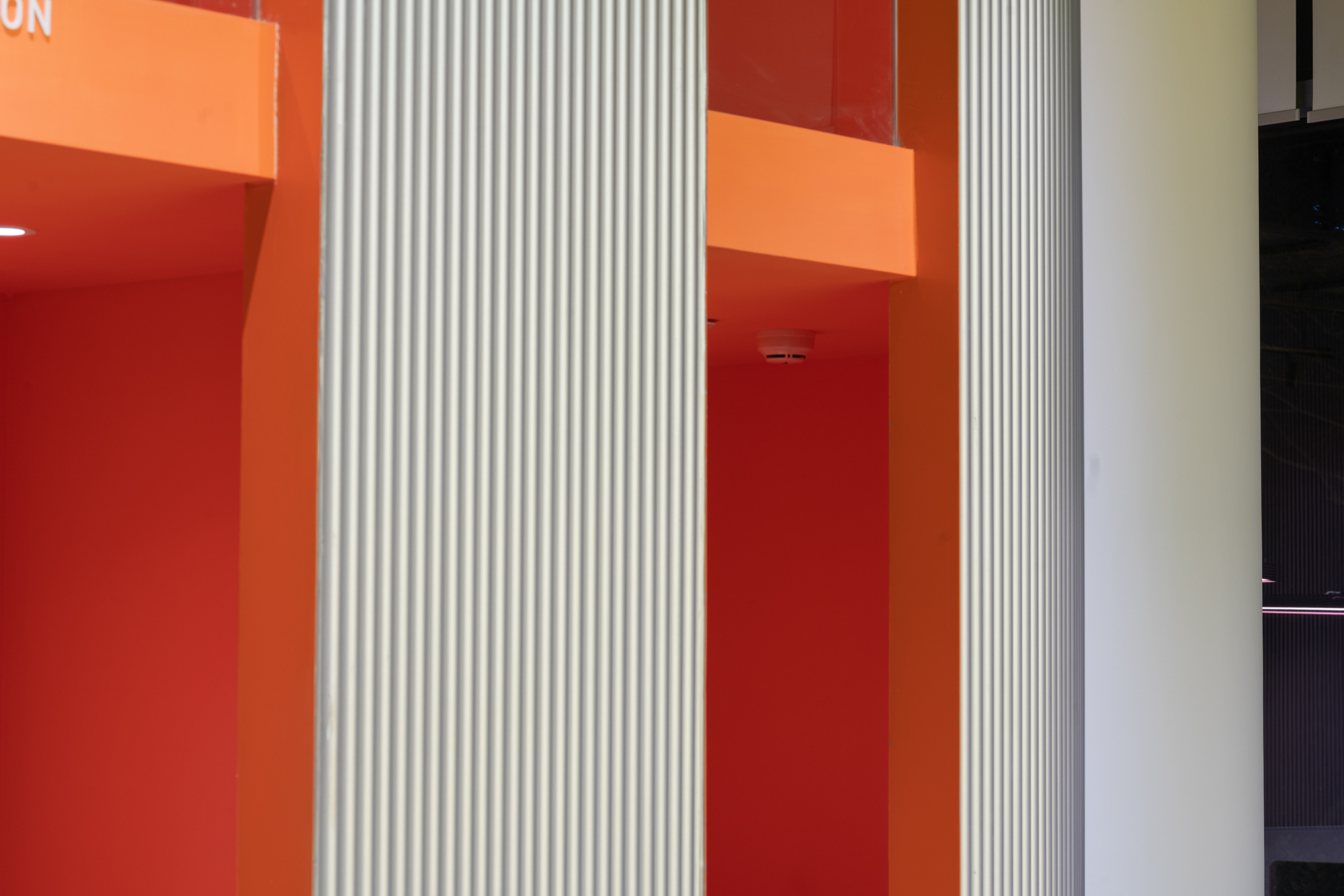

这正是空间由静态向动态转变的开始,空间上开始出现了定义的重叠,这种重叠使得一些室内外的界限变得模糊,使得一些空间开始出现双重身份。这也是探索的另外一种状态,空间不等于房间,静态的物理边界的范式被打破,内与外的定义在这个空间中可以变得更加动态和多元,一些都需要反思,需要再思考。
This is the beginning of the transformation of space from static to dynamic. The overlap of definitions has begun to appear in the space. This overlap has blurred the boundaries between indoor and outdoor areas, and has made some spaces appear to have dual identities. This is also another state of exploration. Space is not equal to a room. The paradigm of static physical boundaries is broken. The definition of inside and outside can become more dynamic and diverse in this space. Some things need to be reflected and thought again.
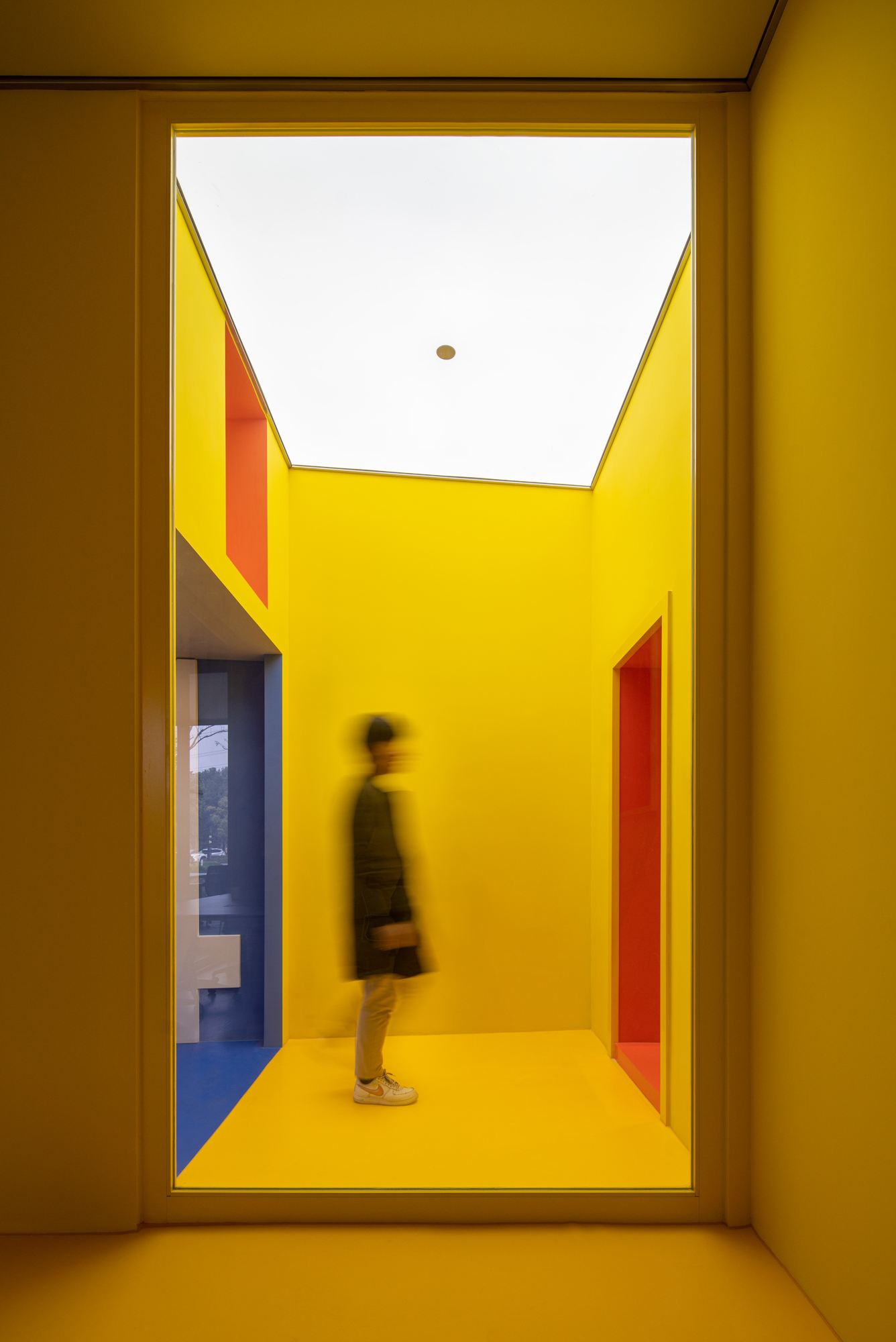
完整项目信息
项目名称:莫比斯加速器众创办公空间
项目类型:办公设计、共享办公、咖啡厅、路演空间、文化社交
项目地点:中科院资本数字经济创新中心
设计单位:杭州植田建筑室内设计工作室、不建建筑(杭州)有限公司
主创建筑师:方润武、王明皓
设计团队:方润武、王明皓、樊江南、麻智超、徐大伟、胡毓滢、郗慧敏、王湘溢、王千慧、洪冲
办公家具:浙江哈迪曼森智能家具有限公司
导视系统设计:梵星工作室
消防:徐小成
业主:国科长三角资本管理有限公司
施工:浙江经典建筑装饰有限公司、徐波
建筑面积:600平方米
设计时间:2021年1月
完工时间:2022年7月
摄影:赵奕龙、方舟
撰文:王明皓、方润武
版权声明:本文由杭州植田建筑室内设计工作室授权发布。欢迎转发,禁止以有方编辑版本转载。
投稿邮箱:media@archiposition.com
上一篇:赫尔佐格与德梅隆新作:阶梯式体量,罗氏瑞士总部2号大楼
下一篇:田上的涟漪:龙门·柒村艺术设计中心 / 时地建筑